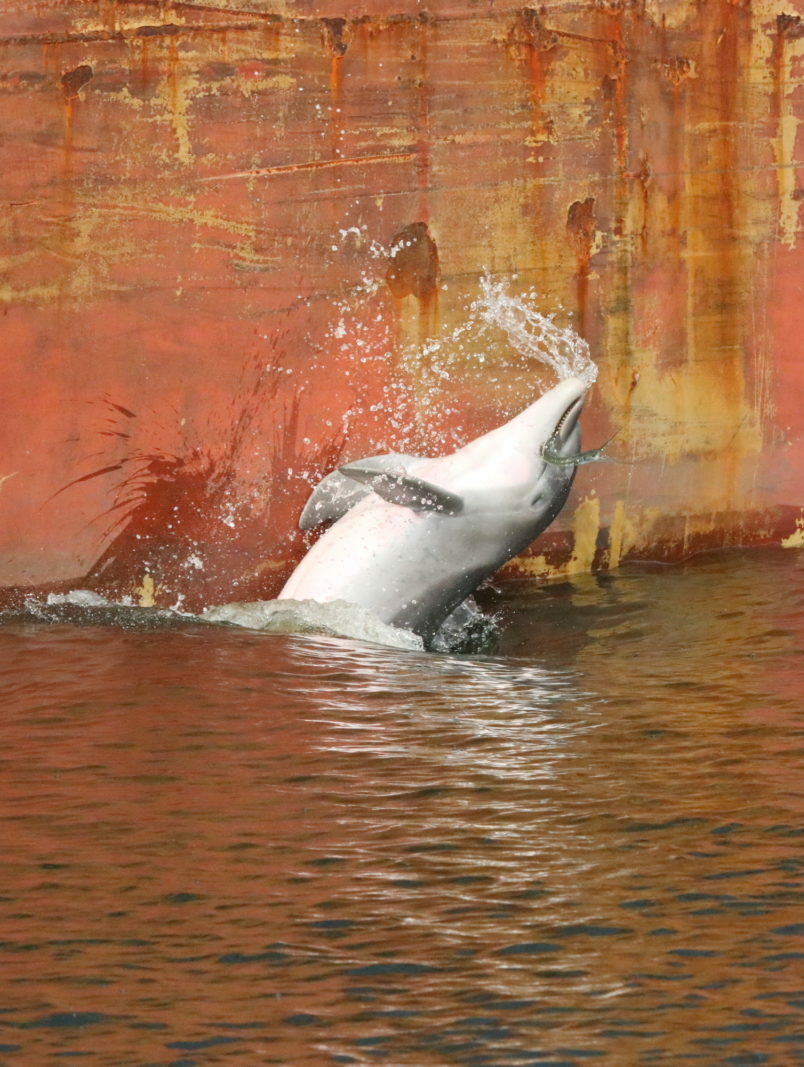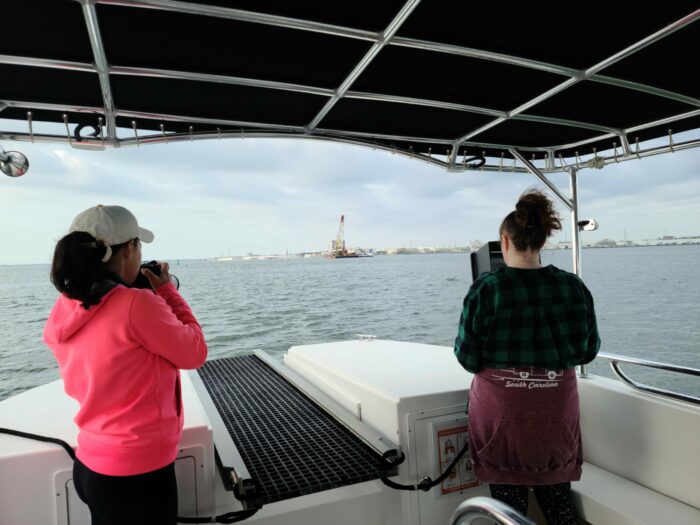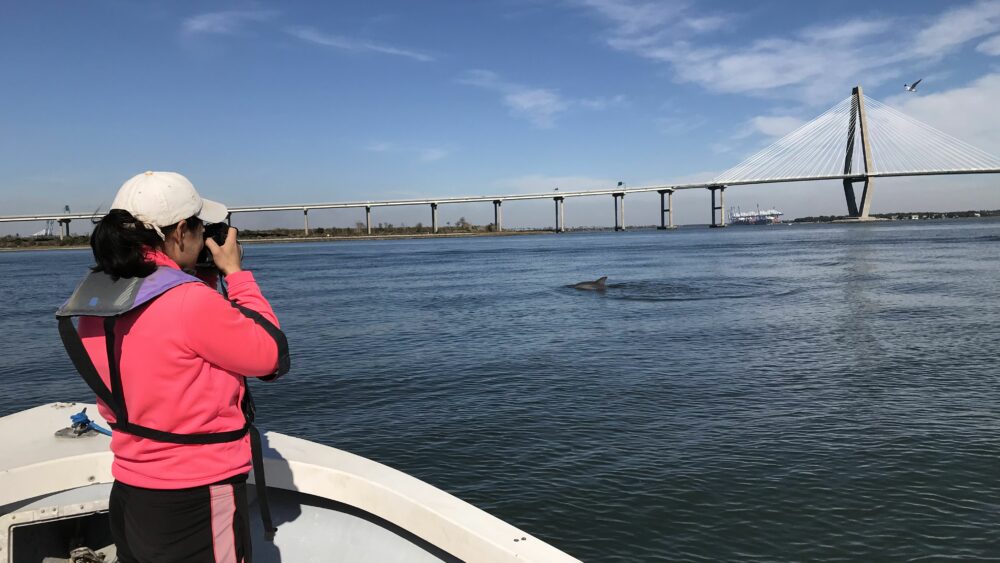You just walked up the main pathway to the Aquarium, and you’re standing by The Shallows looking out over the water. Shipping vessels are passing by, a sailboat glides along in the distance and the Fort Sumter ferry is about to dock next door. Then, you see it — the fleeting glance of a dorsal fin just breaking the glass-like surface of the water. For a split second, you think you’ve spotted a shark in the Charleston Harbor — until you notice the slight arch of a graceful back and the playful flick of a tail… it’s a dolphin!
Throughout the year, anywhere from 300–900 bottlenose dolphins can be found in the Charleston area, 100 of which take up permanent residence here. Aquarium team members, Dr. Patricia Fair, scientist in residence, and Meghan Galipeau, volunteer and teen programs manager and dolphin researcher, have been following our local population closely, identifying six hotspots frequented by dolphins in our waterways. Their research is mainly geared toward studying the impacts of human-related influences on the population, including acoustic disturbances to help develop dolphin population models. But along the way, Dr. Fair and Meghan made an exciting, new discovery.
An Unexpected Surprise
One day, while the team was tracking acoustic disturbances in the Charleston Harbor, they witnessed a group of dolphins corralling fish up against the side of a docked shipping vessel. Though dolphin barrier feeding (a feeding technique where dolphins push prey against a barrier to trap them) has been documented worldwide in various forms — from the United States and Ecuador to Australia and Italy — it had never before been documented against a commercial shipping vessel. Since then, the team has been compiling data on this unprecedented behavior, now known as “shipside feeding.” Shipside feeding is a truly exciting discovery that demonstrates our local dolphin population’s extraordinary ability to adapt to urbanized estuaries.
 A dolphin demonstrates shipside feeding off of a docked vessel in the Charleston Harbor. Photo by MGalipeau, LOC18859
A dolphin demonstrates shipside feeding off of a docked vessel in the Charleston Harbor. Photo by MGalipeau, LOC18859The team also noted the prevalence of mothers and their young participating in shipside feeding. Could our local dolphins be passing down unique, learned feeding techniques to the next generation, creating a network of location-specific behaviors exhibited by this particular population? That remains to be seen — we hope to learn more as the research progresses.
Do You Hear That?
That’s right, our local dolphin population is finding means to adapt to urban estuaries — an ever-changing environment that affects them in more ways than one.
Dolphins have a highly developed sense of hearing, which is critical to their health and wellbeing. With numerous human-induced changes in the Charleston Harbor (like shifts in the soundscape from boat traffic, water sports, dredging and more), the research team wanted to determine its impact on dolphin distribution patterns and abundance — enter Dr. Eric Montie and his team.
In partnership with the University of South Carolina at Beaufort, Dr. Montie joined forces with Dr. Fair and Meghan to add an auditory element to their research. Acoustic recording devices were placed in three separate locations in the Charleston Harbor to record the underwater soundscape throughout specific periods of time. Checking these devices regularly, Dr. Montie and his team downloaded the data and analyzed their findings to determine how auditory, human-related disturbances affect dolphins.
Professor David Lusseau of the University of Aberdeen in Scotland also joined on, applying his population models to our local dolphins. In a previous paper published by Lusseau, his models were applied and resulted in findings of displacements in dolphin populations in Scotland — possibly, in part, due to changes in the soundscape. Lusseau’s models are critical in understanding the impacts of a shifting soundscape on the movements of our local dolphin population here in Charleston.
 While conducting research, Meghan and her teammate spot a dolphin in the Charleston Harbor.
While conducting research, Meghan and her teammate spot a dolphin in the Charleston Harbor.Taking Research to the Sky
Their methods for observation aren’t just confined to the water… they’re in the clouds, too! Thanks to drone technology, the team has a completely new vantage point to collect critical data in a non-intrusive way. This aerial observation could allow them a new way to document dolphin behavior, population size of groups, body condition of individual dolphins and even reproductive status. The introduction of drones is a true game-changer!
How You Can Help
Dolphins are the canaries of the coalmines: If something affects them, it affects us, too. Our dolphin population here in the Lowcountry is not only extraordinary but cherished by the community — it’s important to understand what the research is telling us to course correct accordingly.
You can help safeguard dolphins locally, and beyond, by:
- Abiding by the laws to protect these charismatic creatures, like the Marine Mammal Protection Act
- Admiring them from a distance of 150 feet or more
- Turning off your motors and pulling in your paddles if they’re close
- Posting a spotter; a second set of eyes will help increase your changes of seeing wildlife
- Wearing polarized sunglasses; they will help cut through the water’s glare
- Continuing to learn from emerging research
These efforts can help protect our one-of-a-kind dolphin population and ensure they’re continuing to adapt and thrive for generations to come.
Published September 7, 2022


